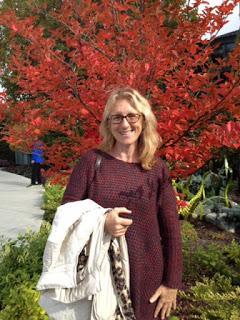
Natural Disaster by Leonardo da Vinci
Yoga Sutra 1.1 “Now, after having done prior preparation through life and other practices, the study and practice of Yoga begins.” —translation from JnaneshvaraFebruary 2016 marks my ten-year anniversary of studying and practicing yoga. I first came to the mat after Hurricane Katrina.I live in Katrina-land, on the Mississippi Gulf Coast, in the shadow of New Orleans, and after the storm, I was ankle deep in mud and devastation. A piece of my porch railing served as a horizontal ladder in my front hall, thrown there by the storm surge that roiled through my house overturning refrigerator and piano, and floating a table loaded with pottery twenty feet down a hall, around a corner, and finally coming rest on top of a fallen mantle with pottery still intact. My life was bayou sludge, dead animals, rotten food, destroyed photographs. I spent months preparing my gutted house for rebuilding and also making the now four-hour drive into New Orleans (90 minutes before Katrina) to work on my destroyed rental property there, where, alone on the desolate city street, I warded off the rumor of armed vandals with the talisman of my large pickup loaded with a generator and shovels.My marriage had been crumbling before Katrina, and the weaknesses of that structure grew, as if the storm surge had poured its polluted waters into all the fracture lines.For months my life was hard physical labor. I was forty-seven and in good shape, but my body wasn’t made for lifting wet mattresses, pushing wheel barrows of soaked drywall, or single-handedly pulling down a tilting carport rotted out by the water. I was pretending I had super powers, which included functioning without self-care. I had a makeshift kitchen where I could cook healthy meals, but mostly I lived on rotisserie chicken, take-out, and wine. Lots of wine to help me sleep in the shell of the house within the shell of a marriage.One afternoon more than a year after the storm, I drove by the local yoga studio and noticed it was open, so I stopped in. I don’t know why. I’ve always been, and still am, skeptical about any organization of any kind. But I went in and the owner, Eileen, was at the desk. I immediately put up as many walls as I could and looked to see how she was ‘other” from me: tattooed, smiling, warm, friendly. I was none of these. We talked a little, and she noticed my black lab had taken over the driver seat of my car. We shared a good laugh about the large dog in the front seat of my Honda Civic. So I decided to try yoga basics and went back that night.My whole life I had been an active person. I’ve been a distance swimmer, a weight lifter, and a long walker. I gave up running in my late twenties when my knees just said no, but I took up aerobics when it was the trend. I felt I had a grip on my body. I had a grip on my body.My first yoga class was gentle yoga basics. Our first practice was three-part or dirgha breath. I could not breathe. As the class progressed, the grip I had on my body became more evident. No muscle cooperated, and I blamed the instructor and the ridiculousness of yoga.As sutra 1.1, says, “through life and other practices” I had prepared myself for yoga. I had trained myself to resist anything my body thought was intelligent. I clung to a completed marriage, I carried glass shower doors over my head for the length of a city block, I loaded a generator and dehumidifiers and thirty pounds of extension cords in a pick-up before sunrise and drove 100 miles to unload it all and spray chemicals on exposed studs to prevent mold. I would not wear a mask. I drank wine for dinner and ate sugar for breakfast. I began the study and practice of yoga with a set of experiences that prepared me for that first class in ways that no one could predict.I sighed and eye-rolled through the most basic of poses, thinking all along this class was a mistake. Then Eileen instructed us through Savasana. The studio had no windows and as I reclined on my mat, I felt safe for the first time in months. My home’s second story was intact and I lived there, but my first floor—on good days a dramatic space full of water views on three sides—was a windblown, door-less, windowless, wall-less space. The dogs delighted in walking through the studs, but I felt exposed to the elements, the hurricanes that came after Katrina, the cold northeast winter winds, the surviving raccoons, possums, snakes. Here on my mat in Savasana, I was cocooned. Eileen talked us through the pose, and I soon felt the breathlessness that precedes sobbing.Then I was sobbing. In February 2005, for the first time since August 29, 2005, I was crying. I had smothered the sobs with heavy lifting, heavy drinking, crazy eating, crazy hours, anger, and more anger. And now the sobs could not stop. I tried to stifle them, and left quickly after class. In my car, I sobbed more and had trouble driving the few miles home, staying in second gear because I could not cry and shift. For once, feeling took precedence.I walked through the dark wind tunnel of the first floor of the house and went upstairs to my bedroom where my then-husband was reading the New York Times on the computer. I sat on the floor and leaned against the bedframe and sobbed until I was retching. He sat in the light of the computer screen and said, “Maybe yoga isn’t for you.”That’s when I knew so many things, the most important being that yoga was for me. The prior preparation I had done “through life and other practices” had led me to the mat, despite my skepticism. My successful attempts at strong-arming through all adversity—through natural disasters and relationship disasters—painted me into a corner. The only way out was to soften into ease and grace.As I come up on my ten-year anniversary, I come to my practice every day with new preparation, new practices. I say to my students, “You bring your whole life to the mat. Your wisdom. Your strength. Your failures. Your attitude about all these things. Use what serves you. Observe what does not. Place it gently to the side. That act, in itself, is a yogic practice. Recognize all the traits you bring to all that you do. Allow your yoga practice to be exactly that: a practice of and for your whole life.” But I am talking to myself. Happy anniversary to me, and to all yoga practitioners who come to the mat for a day, week, year, a lifetime.
Namaste.
Subscribe to Yoga for Healthy Aging by Email ° Follow Yoga for Healthy Aging on Facebook ° Join this site with Google Friend Connect

